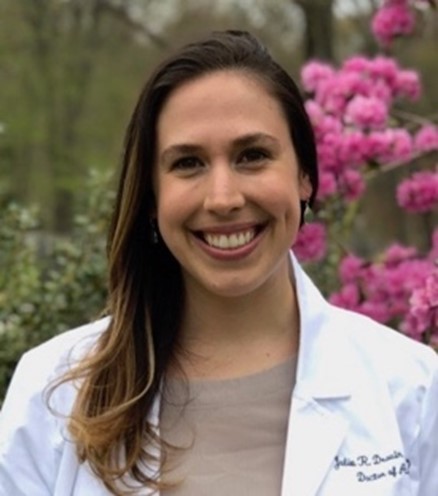Dr. Julia Drouin is an assistant professor at California State University Fullerton in the department of Communication Sciences and Disorders and faculty affiliate at the Center for Hearing Research at the University of California Irvine. She is the principal investigator of the Auditory Language Learning (ALLears) Laboratory. She earned an Au.D. and Ph.D. from the University of Connecticut in 2020, with interdisciplinary training in the neurobiology of language. She completed her clinical residency at the Yale Hearing and Balance Center. Her research program examines how listeners adapt to the acoustic signal of speech, with emphasis on how listeners with hearing loss adapt to devices like cochlear implants.
What inspired you to research hearing rehabilitation?
As clinician-scientist, I have always been interested in research areas that bridge basic science with patient care. My early research examined the mechanisms in our brain that allow us to understand speech even though it may sound really different if, for example, you are listening to a person with an accent or a young child. We call this speech adaptation, which is something that we all encounter in everyday life. Initially, you likely had to work a little harder to follow what that individual was saying but given enough exposure you’re able follow the conversation without a problem.
While I was completing this research, I was in the clinic working with cochlear implant patients and observing tremendous variability in speech adaptation following implantation. Seeing the clinical need to improve patient outcomes drove my desire focus my research on improving speech adaptation.
What is active auditory training and why is it important?
Hearing rehabilitation can be done in several different ways. When we talk about active auditory training, we are referring to listening exercises that involve repeating a word or phrase. I think about auditory training as exercise for the brain; while receiving the cochlear implant is an important part of the process, learning to adapt to the newly transmitted acoustic signal takes time, effort, and continuous practice.
While many cochlear implant users adapt to their device without structured auditory training in place, there is research that demonstrates that recipients are able to achieve better outcomes more quickly when they do participate in hearing rehabilitation.
How can hearing rehabilitation be optimized?
Optimizing the rehabilitation process for individuals with cochlear implants is a primary focus of my research program and an area of active investigation across the field. The ultimate goal is to maximize patient success with a hearing device and maximize spoken language comprehension early in the rehabilitation process. Auditory training is one of many clinical tools to support the rehabilitation process. We hope that our continued research helps to integrate custom recommendations to support individual patient needs.
Based on your research, what’s the relationship between the role of hearing rehabilitation and neuroplasticity?
Neuroplasticity is the mechanism that supports our brain’s ability to change as we learn. While our brains are flexible and change in response to experience, research has shown that age drives this process differently. Consider the last time you tried to learn a new language in adulthood – for most adults, learning a new language can be challenging and slow, whereas children seemingly pick up a new language quickly and with less effort. While both children and adults can learn new skills, children show heightened brain plasticity relative to adults. This has important implications for monitoring how quickly/efficiently a listener adapts to their cochlear implant during the aural rehabilitation process.
For listeners who are adapting to devices like cochlear implants, there’s a significant learning period because the auditory signal transmitted through a cochlear implant is markedly different than the auditory signal available to a normal hearing listener. Because of this, auditory training can improve the process of learning to map the auditory signal onto speech meaning. The brain reorganizes in response to improved spoken language processing. An important note is that there is individual variability in how much auditory training is needed to observe significant speech comprehension improvements and it may be related to neuroplasticity differences.
Any key takeaways that professionals should know?
The aural rehabilitation process is a critical component of cochlear implantation. Auditory training implemented early in the rehabilitation process can help to support spoken language adaptation. Both children and adults can be good candidates to participate in auditory training during the rehabilitation process. Apps like Cochlear™ CoPilot1 can be a great tool for supporting spoken language processing after implantation.
Thank you Dr. Julia Drouin for allowing us to ask a researcher about hearing rehabilitation! Download CoPilot today to get started on rehabilitation!


